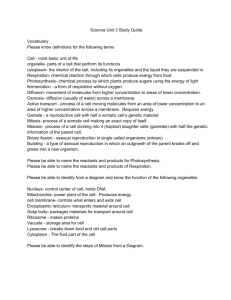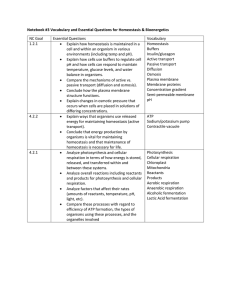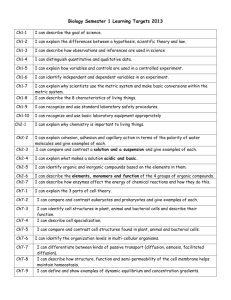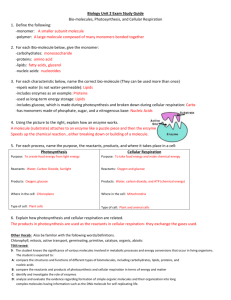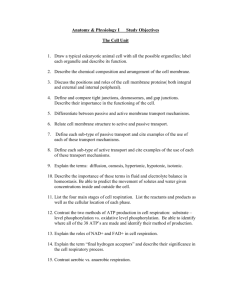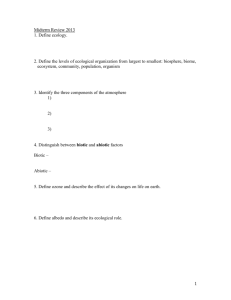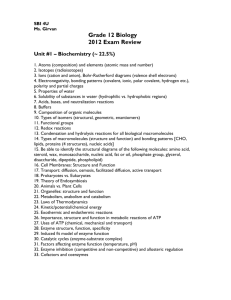Possible Practice Q`s
advertisement
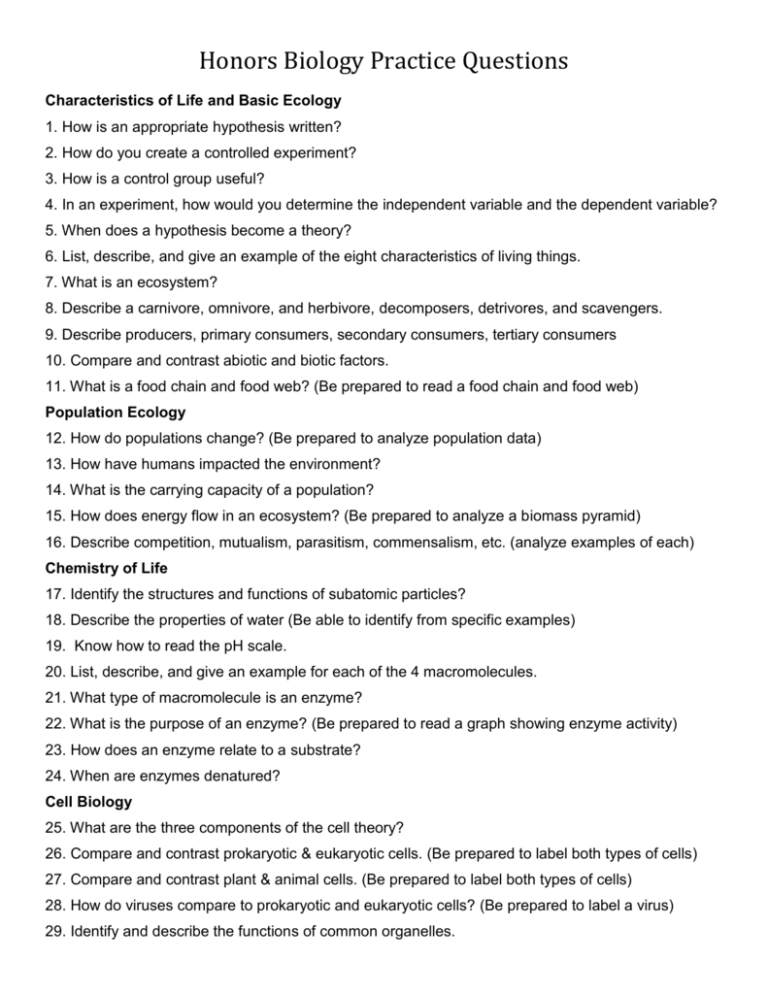
Honors Biology Practice Questions Characteristics of Life and Basic Ecology 1. How is an appropriate hypothesis written? 2. How do you create a controlled experiment? 3. How is a control group useful? 4. In an experiment, how would you determine the independent variable and the dependent variable? 5. When does a hypothesis become a theory? 6. List, describe, and give an example of the eight characteristics of living things. 7. What is an ecosystem? 8. Describe a carnivore, omnivore, and herbivore, decomposers, detrivores, and scavengers. 9. Describe producers, primary consumers, secondary consumers, tertiary consumers 10. Compare and contrast abiotic and biotic factors. 11. What is a food chain and food web? (Be prepared to read a food chain and food web) Population Ecology 12. How do populations change? (Be prepared to analyze population data) 13. How have humans impacted the environment? 14. What is the carrying capacity of a population? 15. How does energy flow in an ecosystem? (Be prepared to analyze a biomass pyramid) 16. Describe competition, mutualism, parasitism, commensalism, etc. (analyze examples of each) Chemistry of Life 17. Identify the structures and functions of subatomic particles? 18. Describe the properties of water (Be able to identify from specific examples) 19. Know how to read the pH scale. 20. List, describe, and give an example for each of the 4 macromolecules. 21. What type of macromolecule is an enzyme? 22. What is the purpose of an enzyme? (Be prepared to read a graph showing enzyme activity) 23. How does an enzyme relate to a substrate? 24. When are enzymes denatured? Cell Biology 25. What are the three components of the cell theory? 26. Compare and contrast prokaryotic & eukaryotic cells. (Be prepared to label both types of cells) 27. Compare and contrast plant & animal cells. (Be prepared to label both types of cells) 28. How do viruses compare to prokaryotic and eukaryotic cells? (Be prepared to label a virus) 29. Identify and describe the functions of common organelles. Cell Transport 30. What are the functions of a cell wall? 31. What are the main functions of the cell membrane? (Be prepared to label a cell membrane) 32. Which cells have a cell membrane? 33. How is a cell membrane selectively permeable? 34. Explain how molecules move for diffusion. 35. Compare and contrast passive and active transport. 36. Compare and contrast the 3 types of passive transport? 37. Explain the difference between hypertonic, isotonic, and hypotonic solutions. 38. If a cell is placed in a hypertonic solution, which way will water move? 39. If a cell is placed in a hypotonic solution, which way will water move? 40. In terms of osmosis, what would happen to a raisin placed in pure water? 41. In terms of osmosis, what would happen if you poured salt on a cucumber? 42. What happens to an animal cell (salt concentration 0.8%) when placed into a 20% salt solution? Cell Energetics 43. Which organisms undergo photosynthesis? 44. Photosynthesis takes place in which organelle? 45. How does chlorophyll relate to photosynthesis? 46. What is the equation to photosynthesis? (Be able to label the reactants and products) 47. Which organisms undergo cellular respiration? 48. Cellular respiration primarily takes place in which organelle? 49. What is the equation to cellular respiration? (Be able to label the reactants and products) 50. Compare and contrast aerobic respiration and anaerobic respiration? 51. Explain how ATP is involved in respiration? 52. What are the reactants and products of each step in aerobic respiration? 53. What are the reactants and products of each step in anaerobic respiration? 54. What are the reactants and products of each step in photosynthesis? Homeostasis 55. What is the difference between positive and negative feedback? 56. Explain homeostasis using the example of thermostat in the home. 57. Describe a positive feedback mechanism found within an organism. 58. Describe a negative feedback mechanism found within an organism. 59. Identify stimuli, effectors, and responses of common biological feedback mechanisms. 60. How does homeostasis help organisms, organs, cells, etc. function ?
